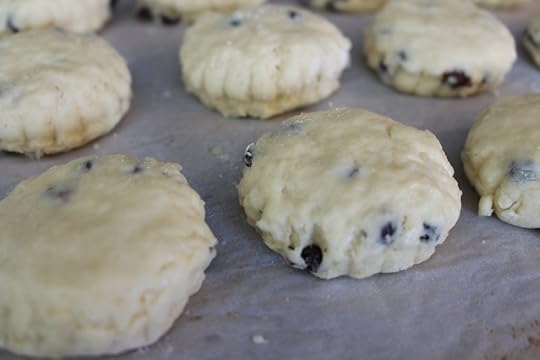The best British scones

When I threw a tea party a few weeks ago, I decided to whip up a batch of scones at the last minute. From where did this unusual burst of insouciance spring? I am not sure. Nevertheless, half an hour before my guests were due to arrive, I found myself hurriedly rubbing butter into flour, and adding – as the recipe specified – “enough buttermilk to make a soft but not sticky dough.” The result was disastrous. The last time I had baked scones was some 30 years ago, and I had no idea of the desired consistency. My dough was too wet, and it stuck everywhere, forcing me to add extra flour, which made the dough too stiff. Far from the delicate, crumbly tea cakes of my dreams, my scones were tough and oddly chewy.
After this experience, I was determined to find the best British scone recipe – one that provided specific measurements. This proved bizarrely difficult. From Sophie Grigson, to Felicity Cloake, to the mother of my friend, Steve – all of them called for approximations of liquid, “enough milk to give a soft, bread-like dough,” or “enough liquid until the dough looks right.” Bollocks, British bakers! Bollocks!
Before I go any further, can we discuss the difference between British and American scones? If you’re an afternoon tea aficionado, perhaps you know that British scones are dainty and round, lightly sweet and reservedly buttery – and generally thought of as a vehicle for even more butter – or, better yet, clotted cream – and heaps of jam, preferably strawberry. American scones are, like so many things, larger, sweeter, and fattier than their old world counterparts, cut into triangles, and larded with dried fruit, nuts, or chocolate chips.
So. If you spend enough time googling “British scones” you will eventually come across all this information, as well as the best British scone recipe ever written for American cooks – and photos, too! – on the Cook’s Illustrated website. Desperate for scone redemption, I spent a morning making these most excellent Cook’s Illustrated scones, studded with currants, and exquisitely delicate.

Most scone recipes are akin to biscuits, calling for cold fat rubbed into flour. Unusually, the Cook’s Illustrated version starts with softened butter, blitzed into the dry ingredients in the food processor until the mixture resembles fine crumbs – you don’t want any visible chunks of butter. Transfer this to a large bowl and add a handful of currants, or not, depending on whether or not you think tiny raisins resemble flies. (Personally, I am faintly repulsed by them visually, but also feel they give a jolly fruity punch.) Stir in the liquid and knead gently (the recipe, admirably precise, specifies 25-30 times).

There are a few other secrets to tall scones – don’t roll the dough out too thin (an inch will suffice), make sure to use a sharp-edged cutter, and when you pierce the dough, do it with a swift and certain hand – and don’t twist! By the way, these colorful, dual-edged cutters were a gift from my mom and I love them.

The scones bake in a hot oven, puffing into delicious, delicate, feathery little cakes. They are fantastic fresh from the oven, but also reheat beautifully at 350ºF for five minutes. Load them with strawberry jam and the leftover clotted cream in the fridge (is that stuff nuclear? because its shelf life is indefinite), and don’t forget to hold out your pinky as you sip your tea.
As they say on my favorite show, “Now that’s a good bike.”

British-style scones
Adapted from Cook’s Illustrated
This Cook’s Illustrated recipe is perfect in every way but for one: As I researched scone recipes, I noticed that it doubled the quantity of flour and butter – and yet produced the same amount of scones. Mysterious! I ended up halving the recipe, and still got 14 scones, dainty and perfect for teatime, but if you desire a large quantity, follow the link to the original.
7.5 oz flour
1 oz sugar
1 tablespoon baking powder
1/4 teaspoon salt
4 tablespoons unsalted butter, softened
1/3 cup Zante currants (optional)
1/2 cup milk
1 egg
Position oven rack to the upper-middle row, and preheat the oven to 500ºF. Line a baking sheet with parchment paper.
In the work bowl of a food processor combine flour, sugar, baking powder, and salt. Pulse a few times.
Cut the butter into 1/2-inch chunks and add it to the flour mixture. Pulse until the butter is completely incorporated into the flour and resembles fine breadcrumbs, about 20 times.
Remove the flour to a large bowl. In a measuring cup, whisk together the egg and milk. Reserve one tablespoon of this mixture. Using a rubber spatula, stir the liquid into the flour mixture until incorporated (a few small bits of flour will remain).
Place the dough on a well-floured surface and gather it into a ball. Flour your hands and knead the dough until smooth, about 25-30 times. Press the dough into a disk and use a floured rolling pin to roll into a round, about 1-inch thick. Cut into rounds with a cutter of 2-2.5 inches. Gather any remaining scraps of dough, knead again, roll, cut, repeat as necessary. Arrange the scones on the prepared baking sheet, and brush their tops with the reserved milk-egg mixture.
Reduce the oven temperature to 425ºF, and bake the scones until lightly golden and well risen, about 10 t0 12 minutes. Remove and cool on a wire rack.

 newest »
newest »
 This recipe looks simple, and the ingredients definitely look much lighter than many scones recipes I've seen..I'm going to give this a try for sure! Thank you!
This recipe looks simple, and the ingredients definitely look much lighter than many scones recipes I've seen..I'm going to give this a try for sure! Thank you!



